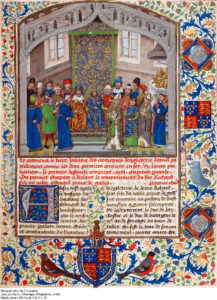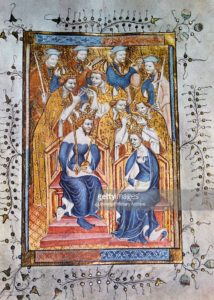 Richard II, also known as Richard of Bordeaux was the son of Edward, the Black Prince and Joan of Kent (“The Fair Maid of Kent”). Richard, at three years of age, became second in line to the throne after his father. As his father died before the death of Edward III on 8 June 1376, Richard, by primogeniture, became the heir apparent to the throne. Edward III died a year later on 21 June 1377 so Richard came to the throne at only 10 years of age. The regency council headed by John of Gaunt.
Richard II, also known as Richard of Bordeaux was the son of Edward, the Black Prince and Joan of Kent (“The Fair Maid of Kent”). Richard, at three years of age, became second in line to the throne after his father. As his father died before the death of Edward III on 8 June 1376, Richard, by primogeniture, became the heir apparent to the throne. Edward III died a year later on 21 June 1377 so Richard came to the throne at only 10 years of age. The regency council headed by John of Gaunt.
Richard was crowned in the Abbey on 16 July 1377, just 11 days after his grandfather’s funeral. The coronation was performed by Simon Sudbury, Archbishop of Canterbury at Westminster abbey. The day before the ceremony he processed on horseback from the Tower of London to Westminster. The men of Bayeux let the procession. After them came representatives of the London wards, corps of German mercenaries, a delegation of Gascons and then earls, barons and knights all dressed in white robes. Next came Richard accompanied by Simon Burley carrying the sword and Nicolas Bonde, a knight of the Chamber who guided the reins of his horse. They travelled along Cheapside, Fleet street and the Strand. The streets were bustling with entertainers and decorated with bright banners and tapestries. The Duke of Lancaster had to cut the path. Wine flowed through Cheapsides conduit for the duration of the procession which took about three hours. This was the first ever coronation procession. It was half a century since the last coronation so there was enormous interest in the occasion. Even a mock castle was erected to the west. In the castle turrets were young girls dressed in white. They showered Richard with gilt scrolls on his approach then descended to offer him wine in gilt cups.
On the day of the coronation, Richard was met at his seat in the palace hall by the Archbishop and clergy. From there he was escorted to a stage in the centre of the church where his throne was placed. The choir sang while the Archbishop vested himself for mass. The Archbishop then led Richard to the altar. Richard made an offering of a pound of gold. Richard the knelt-on cushions and prayers were said. He was the raised up and lead to a chair facing the altar. The coronation oath was the made. Richard swore to uphold the laws and customs of his ancestors, to protect the Church and clergy, to do justice to all to uphold the laws which the people would deem just and reasonable. Basically, the same oath as his grandfather and great grandfather.

Richard shirt was removed behind a golden cloth which hid him now from view. Holy oil was touched on his hands, chest, shoulders and head. He was now God’s anointed. He was given the sword for protection of the kingdom, the sceptre as a tool for correction of error and the ring as a symbol of his pastoral responsibilities. The Archbishop and the Earl of March then placed the crown on Richards head. This was followed by the celebration of mass and performance of homage by leading barons. The King’s Champion, Sir John Dymock appeared at the Abbey door but postponed his challenge as was custom. On completion of the ceremony the procession left the Abbey for Westminster Hall. Simon Burley carried the king shoulder high resulting in the king losing one of his shoes.

He married Anne daughter of the Emperor Charles IV of Bohemia, and sister of King Wenceslas IV, in Westminster Abbey in January 1382 and was devoted to her. She was crowned two days later by Archbishop Courtenay. In 1396 he married the Isabella of France (Valois) who was only 7 years of age. She was coronated she received a coronation in Westminster Abbey on 8 January 1397.
In 1399, at the Tower of London Richard was pressured to sign away the crown to his cousin, Henry IV, son of the powerful John of Gaunt, Duke of Lancaster.
